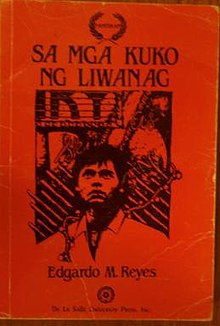My cobbled-together English translation of the epigraph to the first chapter of Edgardo M. Reyes’ Sa Mga Kuko ng Liwanag seems an apt text for the opening of this personal and academic site. This is a deliberately rough translation, far more literal than literary — the scaffolding for a later, and more polished, work. 
Edgardo M. Reyes, Sa Mga Kuko ng Liwanag (Quezon City: De La Salle University Press, 1986)
Sa simula, siya’y isang kalansay na nakatalalan sa hangin. Isang matayog, buhaghag na bunton ng patapong mga piraso ng tablang gato, mabukbok, mabitak, masalubsob, pilipit, kubikong, na pinagpaku-pako nang patayo, pahalang, patulibas, kabit-kabit nang walang wawa, tulad ng kahig-manok sa lupa, at dito’y sisingit ang mga tadyang na bakal at ang mga yero at mga playwud at mga lawanit upang saluhin ang buhos ng labusaw na halo ng tubig, graba, buhangin at semento, at ang malabsang sangkap ay sisiksik at titigib sa hulmahan, matutuyo, titigas, yayakap sa mga tadyang na bakal at sa mga bitukang tubo. Bawat buhos ng malabsang sangkap ay karagdagang laman ng kanyang katawan, karagdagang guhit sa tutunguhing anyo. Unti-unting mapapalis ang mga kalansay na kahoy, kasabay ng unti-unting paglapad at pagtaas ng katawang konkreto. Kikinisin siya, dadamitan ng salamin, tisa, marmol at pormika, hihilamusan ng kulay upang umalindog ang kanyang balat. At sa kanyang ganap na pagkaluwal ay bibinyagan siya, at ang pangalan niya’y iuukit sa tanso.
Sa simula, siya’y isang kalansay na nakatalalan sa hangin. Pagyayamanin siya, maglalaman at lulusog sa dilig ng pawis at dugo. At siya’y matatayo nang buong tatag, lakas at tibay, naghuhumindig at nagtutumayog sa kapangyarihan, samantalang sa kanyang paanan ay naroon at lugmok, lupaypay, sugatan, duguan, nagtingala sa kanyang kataasan, ang mga nagpala sa kanya.
Sa simula, siya’y isang kalansay na napahahabag, at nagwakas na isang makapangyarihan, palalong diyos.
There is a great deal going on in this marvelous opening passage. There are shades of Feuerbach and Marx, as the alienation of the construction workers is expressed in language of fetish and projection. Among the workers — prostrate and collapsed — is the protagonist Julio Madiaga. There is a marvelous and untranslatable ambiguity to the verb nagpala, which conveys simultaneously shoveling and blessing. Bound up in this single commonplace word are both the spiritual alienation and economic exploitation of the working class in Reyes’ novel.
In the beginning it was a skeleton struggling in the air. A towering, loose heap of thrown-off pieces of rotten wood, worm-ridden, split, splintered, twisted, cubiform, nailed standing, jutting, crossing, senselessly cobbled together, like chicken scratches in the dirt, and here will joint the steel ribs, galvanized iron, plywood and particle board to catch the turbidly flowing mixture of water, gravel, sand and cement, and the pulped material will squeeze into and overfill the mold, dry, harden, embrace the steel ribs and the pipe intestines. Every pour of pulped material is added flesh on its body,an added line to the intended figure. The skeleton of wood will slowly be swept away as the concrete body slowly widens and rises. It will be polished, dressed in glass, tile, marble and formica, facewashed with color to pretty its skin. And at its complete birth it will be christened and its name engraved in bronze.
In the beginning it was a skeleton struggling in the air. It will be enriched, fattened and given health by the watering of sweat and blood. And it will stand in perfect stability, strength and sturdiness, erect and towering in power, while at its feet are – and prostrate, collapsed, wounded, bloody, faces turned upwards to its height – the ones who shoveled it.
In the beginning it was a pathetic skeleton; in the end a powerful, arrogant god.
